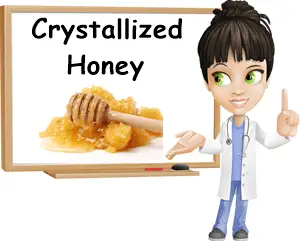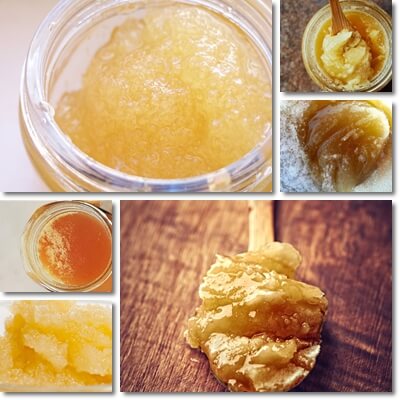Crystallized honey often sits for months on end on supermarket shelves and doesn’t get a second look. A lot of times it’s because people are under the impression that crystallized honey is spoiled honey or old honey. But there’s really no sound reason to avoid it: except for being harder to scoop out of the jar and grainier in texture, crystallized honey is just as nutritious and good for you as liquid honey. It retains the same amounts of vitamins and minerals and still has antimicrobial enzymes such as hydrogen peroxide and an acidic pH and high density, two of the reasons behind its demulcent properties and benefits for sore throat, cough and for stomach pain and excess stomach acid.
What is crystallized honey?
Crystallized honey is simply solidified honey. Crystallization oversees the formation of tiny sugar crystals in liquid honey leading to complete solidification over a certain period of time. But should honey crystallize? Absolutely! Crystallization is a perfectly natural process that occurs with raw honey, irrespective of variety. Of course, not all varieties crystallize at the same rate – depending on the ratio of fructose to glucose (the two main sugars in honey), crystallization may occur anywhere between a week and several years.

What makes honey crystallize?
What makes honey crystallize is the sugars in it. The average sugar content in raw honey is over 80 – 82%. Fructose and glucose are the main sugars in raw, unadulterated honey – they are simple sugars and determine both sweetness and crystallization time. A higher content of fructose in honey makes it sweeter even than table sugar and staves off crystallization. An equal or higher content of glucose promotes crystallization.
So what makes real, raw honey crystallize is a higher glucose content – the higher the content, the faster the crystallization time. Honey that is more fructose than glucose crystallizes fairly slowly.
For example, black locust, false acacia or simply acacia honey is typically higher in fructose, with an average fructose content ranging of 38% (sometimes well over 47%). Versus glucose content which is usually between 21% and 32%. This fructose-to-glucose ratio causes acacia honey to stay liquid longer, often times for years. But variations in the content of different sugars is honey are determined by floral source and can vary with region, season and batch, which is why honeys belonging to the same floral source won’t always crystallize at the same rate. That is, your raw acacia honey can stay liquid for years, or crystallize after 12-18 months.
What does crystallized honey look like?
Honeys naturally range in color, depending on the nectar source. Those color variations are retained in a lot of their crystallized versions, except that the crystallized honeys are opaque and have a more muted color. For example, liquid sunflower honey is a beautiful amber color with orangey reflexes, but sunflower honey that has crystallized is opaque and a duller, lighter yellow color. Sunflower honey crystallizes naturally in 3 weeks to 2 months due to its higher glucose content.
Liquid buckwheat honey is a dark amber color, with copper, reddish brown, dark purple or black reflexes. When it crystallizes, and does so slowly, it becomes opaque and lighter-colored, a dull amber color with copper or reddish-brown reflexes.

What does crystallized honey taste like?
When it comes to the taste of crystallized honey, there may be some differences depending on the fructose-glucose ratio of the variety and the floral sources. Overall, crystallized honeys will not only have a rougher or grainier texture, but sometimes also a slightly more muted flavor profile compared to their liquid versions. Some varieties form larger sugar crystals which gives them a coarser texture and makes them hard to scoop out of the jar and spread, whereas others form smaller, finer crystals that give them a more pleasant, softer, albeit solid consistency. For example, rapeseed honey, which has a higher glucose-to-fructose ratio, crystallizes fast, in only 3-4 weeks, but forms finer crystals which give it a softer, more spreadable consistency. The taste is muted, not very persistent, characterized by moderate sweetness, medium intensity and warm floral flavors with faint oily undertones.
Is crystallized honey still good?
There’s no greater myth than the one saying that crystallized honey is spoilt and bad for you. The fact is that crystallized honey is still perfectly okay to eat and just as good for you as liquid honey. It provides the same range of benefits, despite the solid consistency and less appealing texture. Liquid honey crystallizes naturally and crystallization is actually a good way to tell if your honey is pure and not fake or adulterated.
What happens when honey crystallizes is sugar crystals form and slowly turn the entire honey solid. It’s really just a mechanical process that causes no changes to the properties and health benefits of the honey. But why does honey crystallize? Because that’s what it does: real, raw honey will crystallize after a certain period of time. Crystallization, while unappealing to the palate, has the benefit of increasing shelf life and preserving the honey. While varieties high in glucose will inevitably crystallize soon after harvest, keeping your honey in the fridge, at 4 degrees Celsius or lower helps delay crystallization. Keeping your honey sealed and at room temperature, around 22-25 degrees Celsius, also helps keep it liquid for longer.
How to use crystallized honey
What do you do with honey that has crystallized? The best answer would be eating it. Preferably raw. It doesn’t spread on bread as easily as liquid honey, but you can scoop out pieces to add to a warm leafy greens, chicken breast and peach or nectarine salad, with crunchy walnuts, pecans or almonds and maybe some feta cheese too. Or take it on an empty stomach in the morning to help soothe a sore throat caused by nighttime heartburn due to acid reflux. Or add it to a warm herbal tea or even coffee – it will liquefy immediately and become soft and smooth.
You can use crystallized honey for skin care: scoop out a teaspoon from a jar, warm it between your hands to make it easier to work with, then gently rub on your face to exfoliate and combat acne, dryness, dullness or improve the appearance of an uneven skin tone. Crystallized honey just as it is a good scrub for your skin, face and body. Or you can stir it until you break the larger crystals into smaller ones and get a smoother, creamier honey, also known as creamed honey.
Nutrition facts
Crystallized honey is just as nutritious, healthy and good for you as raw, liquid honey. In terms of nutrition, you still get trace amounts of essential vitamins and minerals (vitamin C, B vitamins, copper, calcium, iron, magnesium, manganese, phosphorus, potassium, zinc), dietary fiber (0.2 g of fiber/100 g), protein with both essential and non-essential amino acids (0.3 g of protein/100 g), antioxidants and volatile organic compounds, antibacterial, antiviral and antifungal enzymes (hydrogen peroxide, methylglioxal), organic acids (gluconic, acetic, citric, lactic, malic acid and more), and over 80-82 g of carbohydrates, mostly fructose, glucose, but also other sugars (sucrose, maltose).
How is crystallized honey good for you?
The health benefits of crystallized honey are no different from the health benefits of liquid honey. So long as it’s consumed raw, not cooked, it can help with the following:
- Soothes sore throat irritation and calms cough caused by upper respiratory tract infections, heartburn and acid reflux or allergies.
- Has a local antibacterial and anti-inflammatory action: its natural density forms a protective coating over mucous membranes and skin, while its acidic pH and antimicrobial elements (hydrogen peroxide, methylglyoxal) actively inhibit bacteria growth.
- Boosts the immune system – pollen, propolis and other elements occurring naturally in honey have immune system-modulating effects.
- Helps manage and promote healing of gastritis and peptic ulcers caused by excess stomach acid production when taken on an empty stomach (dietary changes are also needed).
- Raises blood sugar levels and combats hypoglycemia.
- Some honeys also have benefits for diabetes – varieties with a low glycemic index (below 55) raise blood sugar levels slowly and steadily which is good for the management of diabetes type 2.
- Probiotic benefits from naturally-occurring enzymes.
- Antiviral, antifungal and antioxidant benefits.
- Benefits for skin: provides gentle exfoliation and helps manage acne-prone skin; clears excess sebum gently and provides hydration for oily skin; combats dryness, dullness, redness, promotes faster healing of small wounds and is good for an uneven skin tone.
